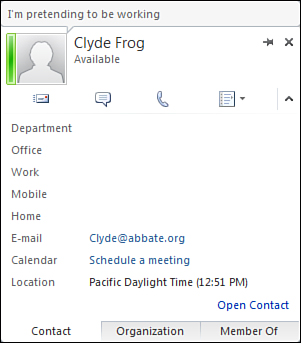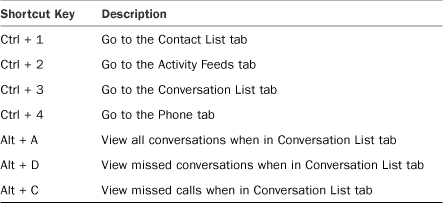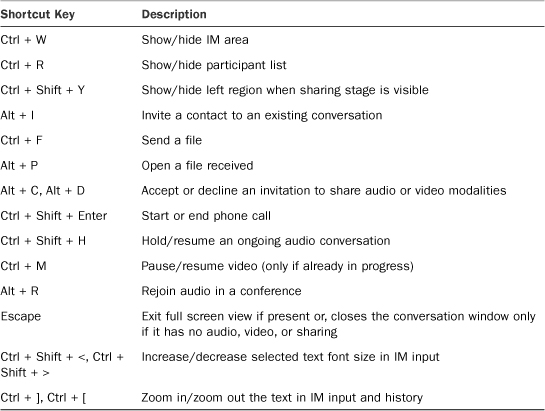1. Integration with Outlook
One of the strongest areas of integration for the Lync client is
with Outlook. When the Lync client is installed, it adds several
buttons to the Respond area of the Outlook toolbar. This gives the
following options:
• Meeting
• IM Reply
• IM Reply to All
• Call
• Call All
Instead of being locked into responding to an e-mail with another
e-mail, you can choose to start up an IM conversation, initiate a voice
call, or initiate a web conference. This offers tremendous flexibility
in how to collaborate with coworkers.
This integration extends to the contacts
managed by Outlook. By looking at an e-mail received from a coworker
and double-clicking that person’s name, you see the integrated Lync
functionality on the contact card. Figure 1
shows how you can trigger an IM, a call, or immediately start a shared
desktop conference with the other user. You can also see the presence
information for the other user, which often influences how you respond.
Figure 1 Contact Cards in Outlook

Integration with Calendar View
Another integration between Lync Client and Outlook is in the
Calendar view. You will quickly notice a New Online Meeting button in
the main bar containing the Lync logo. Clicking this button launches
the traditional meeting interface where you can invite attendees and
attach agenda information. Additionally, it embeds a link that enables
invitees to join an online conference. In the invite pane, there are
two more Lync buttons:
• Join Online Meeting
• Meeting Options
Join Online Meeting accomplishes the same thing as clicking the
embedded link and joins the conference. The Meeting Options button
enables the meeting creator to define access behaviors and to define
who can and cannot act as a presenter. In the meeting link is a second
link that leads to online help information for answering common
questions for first-time meeting organizers.
Integration of Presence Information
The last area of integration is presence information. When looking
at e-mail messages from other Lync Server 2010 users, you can see their
current status. Administrators who are familiar with older versions of
OCS notice that the presence circle is now a rounded square. Hovering
the mouse over the presence icon gives additional information and exposes the menus to immediately send an IM, place an audio or video call, schedule a meeting, or start sharing resources.
2. Integration with Office
Lync offers some integration with Microsoft Office that can make it
easier to collaborate with other users. For example, in Microsoft Word,
you can go into the File area of the ribbon and look at the info page.
The name of the person who authored the file and the name of the person
who last edited the file are located on the far right. Notice that the
presence jellybean is shown next to each of the names with accurate
presence information. If you have a question about the last set of
edits made to a document, simply hover over the “last modified by” name
to get the option to IM or call that person through Lync. This level of
integration makes collaborative communications easy, and they quickly
become second nature for most users.
Lync integration with Office also adds two share options in the
Review ribbon. You can send the document to a contact through the Send
by IM button or you can click Share Now and choose a contact to open a
screen-sharing session with that user. This enables two people to share
the document and make changes to it collaboratively.
3. Useful Lync Client Shortcuts
Microsoft has gone out of its way to improve functionality and
accessibility in the Lync client, and one of the ways is to create
hotkeys for commonly used tasks. This sort of information makes a great
cheat sheet for new users of the Lync client because it not only
simplifies accessing certain functions, it also serves to highlight
what functions are available. Some of those commonly used tasks are
highlighted in Table 1:
Table 1 Global Hotkeys

Table 2 Main Window Shortcuts

Table 3 Conversation Window Shortcuts
